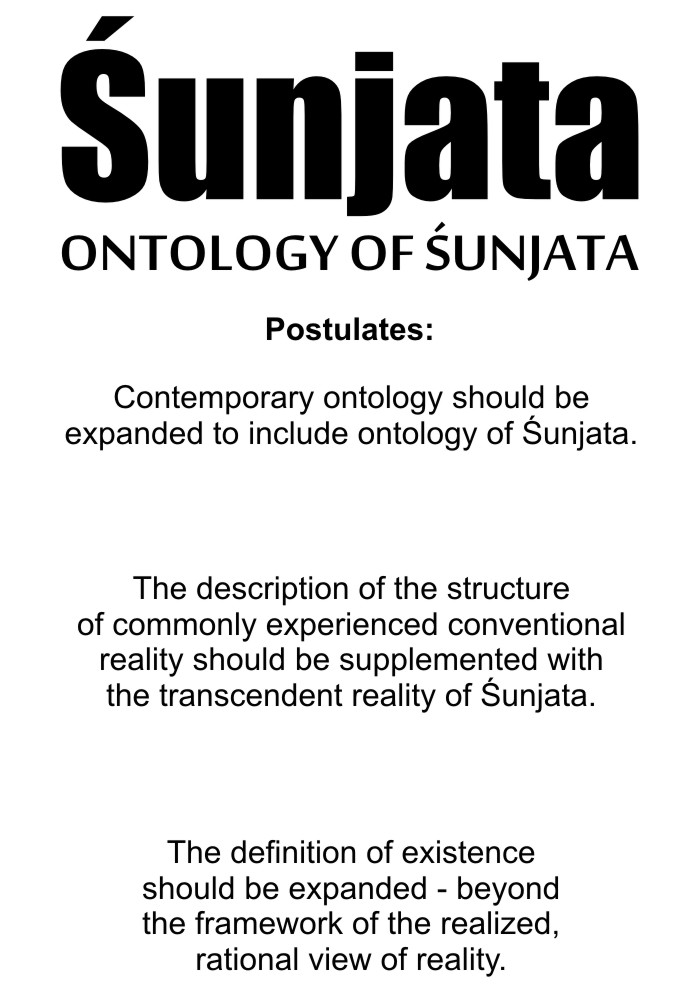| painting krzysztof kuszej | Ontology and Shunyata | |||
|
(The translation may not be completely consistent with the original, as it is based on online translation programs.) Ontology and Shunyata. Philosophical conclusions:
The significance of images goes beyond aesthetic values. Images are documents describing a reality that truly exists, transcendent of common conventional reality - the reality of Śunjata, which is experienced recursively and can be explored rationally. Descriptions of intersubjective cognition of Śunjaty's reality are empirically confirmable, and the content of the paintings is prepared for independent verification and criticism. Artistic formal exploration finally came to an end in the 20th century. From impressionism, cubism through abstractionism and conceptualism. Art has reached the end of the formal search. The end of Art was proclaimed. However, it turned out that this was the end of certain ideas about art. Contemporary art proposes something more than playing with texture, color, composition, or freely chosen objects. A work of art without a coherent message, is just an aesthetic object. Painful evidence of a failure to understand the challenges of modernity. The complexity of the modern world requires more than an attitude that promotes unlimited and free interpretation of an artistic work. Art for art's sake is already just a craft. It is dead. It is the coherent, deeper content, not the form, that proves the quality of an artistic message today. Rather, it is the precisely constructed idea rather than merely the artistic object that is the work of art today. Mathematics and physics, in the face of their latest discoveries, are often helpless to explain them, psychology and philosophy do not provide answers to fundamental questions. These limitations can only be overcome through a change of consciousness. A consciousness deepened by knowledge of the functioning of the mind, and knowledge of the true structure of reality. This knowledge can be gained by working on the mind, using methods developed by Eastern cultures. Meditation techniques are the best tool for this today. Meditation allows one to look at reality from a non-Western perspective. Properly guided, it uncovers the fallacies of a mind dominated by the inner conscious Self. Through meditation, it is possible to reduce the activity and even turn off those areas of the mind that are responsible for a subjective, distorted view of the world. This in turn allows one to observe reality in its pure, absolute dimension. The watershed moment in the process of consciousness change is the experience of parallel reality (Śunjata). In this state, it is possible to view reality without the mediation of the conscious inner Self. The form of the external world comes from the mind. Shunyata is not a mental construct of any kind. Shunyata is a real, actual reality. It can be experienced through the senses. See it, or hear it, or feel it by touch, probably smell it too. But it can never be known through any form of thinking. The inspiration for the paintings is the reality of Śunjata. However, I am not a Buddhist. I am an atheist. I recognize the enormous potential inherent in meditation techniques. Where further psychology can no longer reach, where psychotherapy no longer reaches, that's where meditation reaches. In my work I use Buddhist methods of altering consciousness, using techniques from many Eastern schools. I use these experiences in painting, trying to translate the successive stages of development into a painting. I try to show the complexity and simplicity at the same time, the fundamental peculiarity of Śunjata - the uniqueness of the experience of being in absolute emptiness, without an inner conscious Self, in a state of pure mind. A mind devoid of all the dirt that accumulates over a lifetime: habits, opinions, thoughts, feelings, learning and knowledge, past and future. This awareness creates a new perspective of seeing reality. This is the true nature of the phenomena around us, free of humanity. The title of each painting is also a commentary. The comments complement the painting by creating a whole with it. Painting, operating with the language of symbols, has its inherent limitations. Literary language has a completely different kind of limitations. The combination of these two means of expression provides an opportunity to create a fuller and complete message. Lodz, Poland 2023 |
||||
| paintings 17 (2024) | ||||
| paintings 16 (2024) | ||||
| paintings 15 | ||||
| paintings 14 | ||||
| paintings 13 | ||||
| paintings 12 | ||||
| paintings 11 | ||||
| paintings 10 | ||||
| paintings 9 | ||||
| paintings 8 | ||||
| paintings 7 | ||||
| paintings 6 | ||||
| paintings 5 | ||||
| paintings 4 | ||||
|
||||
